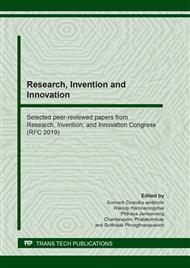p.205
p.211
p.218
p.224
p.230
p.237
p.245
p.253
p.261
Effect of Solvent Cleaning on Thermo-Mechanical and Rheological Properties of Plastic Wastes from Municipal Solid Waste (MSW)
Abstract:
The plastics from municipal solid waste (MSW) were modified to improve cleanness for adding value. The stir and sonication were performed as cleaning processes. Xylene, tetrachloroethylene, chloroform, acetone and toluene were used as solvent cleaning. The most suitable cleaning process was sonication method with cleaning time of 5 min and the appropriate solvent was xylene for washing the plastic wastes for further study in terms of thermo-mechanical and rheological properties. The cleaning process was successful as evidence in thermogravimetric analysis (TGA) results. The properties of new plastics, cleaned plastic wastes and plastic wastes were compared and analyzed. Tensile strength of the specimens from plastic wastes was slightly decreased; however, elongation and impact strength of cleaned plastic wastes and plastic wastes sharply dropped as compared to new plastics. Tensile modulus of cleaned plastic wastes was slightly better than that of new plastics. Thermal stability of plastic waste was slightly lower than that of new plastic. Shear storage modulus (Gʹ), shear loss modulus (Gʺ) and shear viscosity (η) of new plastics showed the maximum value; on the other hand, those properties of cleaned plastic wastes and plastic wastes were similar. The cleaning method with solvent did not destroy thermo-mechanical and rheological properties of the cleaned plastic wastes.
Info:
Periodical:
Pages:
230-236
Citation:
Online since:
August 2020
Authors:
Price:
Сopyright:
© 2020 Trans Tech Publications Ltd. All Rights Reserved
Share:
Citation:


